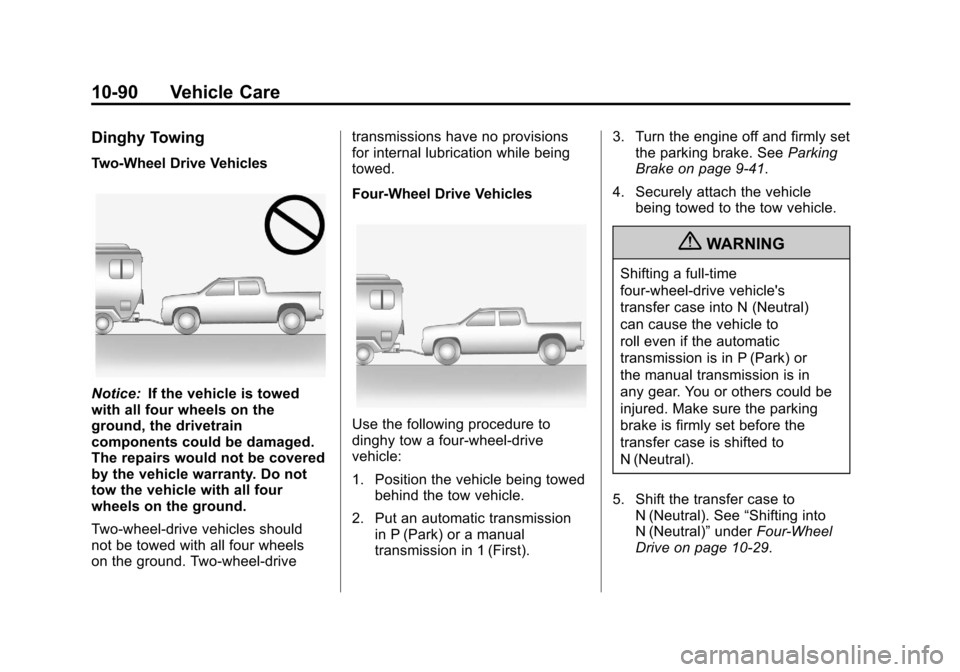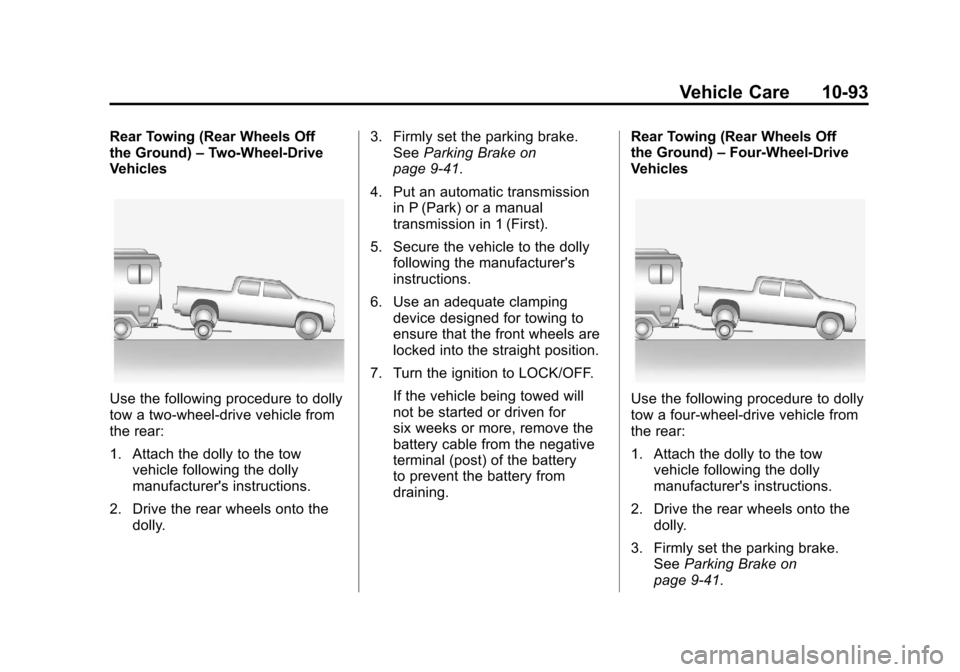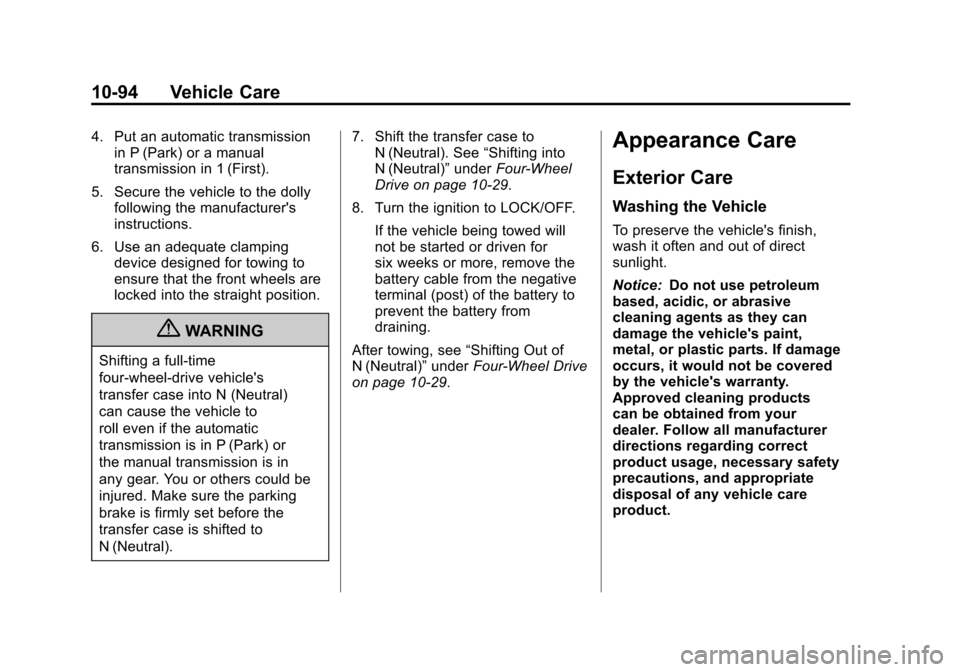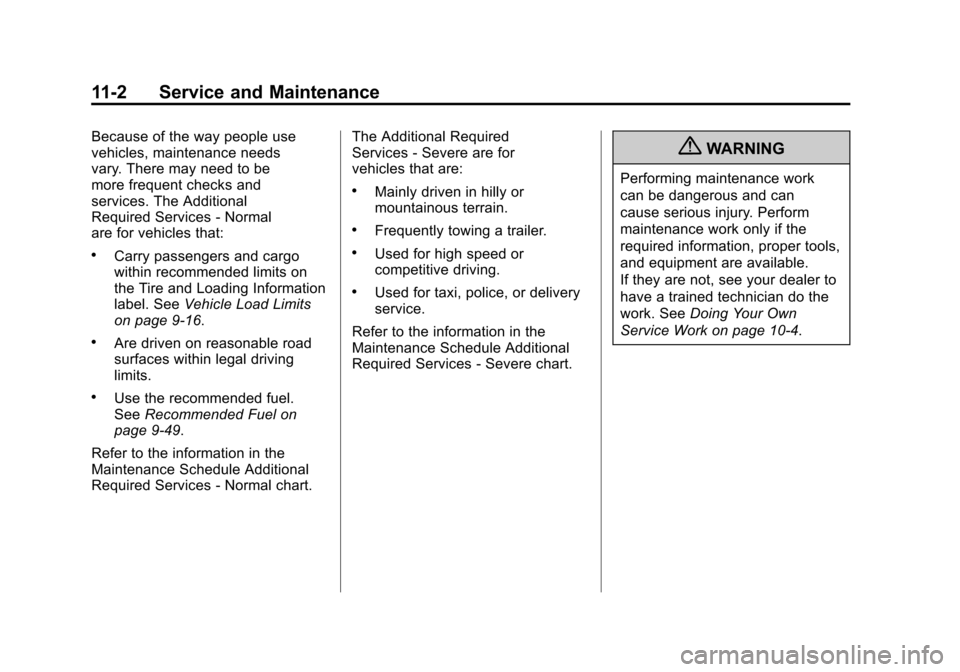2012 CHEVROLET COLORADO towing
[x] Cancel search: towingPage 328 of 394

Black plate (90,1)Chevrolet Colorado Owner Manual - 2012
10-90 Vehicle Care
Dinghy Towing
Two-Wheel Drive Vehicles
Notice:If the vehicle is towed
with all four wheels on the
ground, the drivetrain
components could be damaged.
The repairs would not be covered
by the vehicle warranty. Do not
tow the vehicle with all four
wheels on the ground.
Two-wheel-drive vehicles should
not be towed with all four wheels
on the ground. Two-wheel-drive transmissions have no provisions
for internal lubrication while being
towed.
Four-Wheel Drive Vehicles
Use the following procedure to
dinghy tow a four-wheel-drive
vehicle:
1. Position the vehicle being towed
behind the tow vehicle.
2. Put an automatic transmission in P (Park) or a manual
transmission in 1 (First). 3. Turn the engine off and firmly set
the parking brake. See Parking
Brake on page 9‑41.
4. Securely attach the vehicle being towed to the tow vehicle.
{WARNING
Shifting a full‐time
four‐wheel‐drive vehicle's
transfer case into N (Neutral)
can cause the vehicle to
roll even if the automatic
transmission is in P (Park) or
the manual transmission is in
any gear. You or others could be
injured. Make sure the parking
brake is firmly set before the
transfer case is shifted to
N (Neutral).
5. Shift the transfer case to N (Neutral). See “Shifting into
N (Neutral)” underFour-Wheel
Drive on page 10‑29.
Page 329 of 394

Black plate (91,1)Chevrolet Colorado Owner Manual - 2012
Vehicle Care 10-91
6. Turn the ignition to LOCK/OFFand remove the key —the front
wheels will still turn.
7. Release the parking brake only after the vehicle being towed is
firmly attached to the towing
vehicle.
After towing see “Shifting Out of
N (Neutral)” underFour-Wheel Drive
on page 10‑29.
If the vehicle being towed will not be
started or driven for six weeks or
more, remove the battery cable from
the negative terminal (post) of the
battery to prevent the battery from
draining.Dolly Towing
Front Towing (Front Wheels Off
the Ground) –Two‐Wheel‐Drive
Vehicles
Notice: If a two-wheel-drive
vehicle is towed with the rear
wheels on the ground, the
transmission could be damaged.
The repairs would not be covered
by the vehicle warranty. Never
tow the vehicle with the rear
wheels on the ground. Two-wheel-drive vehicles should not
be towed with the rear wheels on
the ground. Two-wheel-drive
transmissions have no provisions
for internal lubrication while being
towed.
To dolly tow a two‐wheel‐drive
vehicle, the vehicle must be towed
with the rear wheels on the dolly.
See
“Rear Towing (Rear Wheels Off
the Ground)” later in this section for
more information.
Page 330 of 394

Black plate (92,1)Chevrolet Colorado Owner Manual - 2012
10-92 Vehicle Care
Front Towing (Front Wheels Off
the Ground)–Four-Wheel-Drive
Vehicles
Use the following procedure to dolly
tow a four-wheel-drive vehicle from
the front:
1. Attach the dolly to the tow
vehicle following the dolly
manufacturer's instructions.
2. Drive the front wheels onto the dolly. 3. Put an automatic transmission
in P (Park) or a manual
transmission in 1 (First).
4. Turn the engine off and firmly set the parking brake. See Parking
Brake on page 9‑41.
{WARNING
Shifting a full‐time
four‐wheel‐drive vehicle's
transfer case into N (Neutral)
can cause the vehicle to roll even
if the automatic transmission
is in P (Park) or the manual
transmission is in any gear. You
or others could be injured. Make
sure the parking brake is firmly
set before the transfer case is
shifted to N (Neutral).
5. Secure the vehicle to the dolly following the manufacturer's
instructions. 6. Shift the transfer case to
N (Neutral). See “Shifting into
N (Neutral)” underFour-Wheel
Drive on page 10‑29.
7. Release the parking brake only after the vehicle being towed is
firmly attached to the towing
vehicle.
8. Turn the ignition to LOCK/OFF.
After towing, see “Shifting Out of
N (Neutral)” underFour-Wheel Drive
on page 10‑29.
If the vehicle being towed will not be
started or driven for six weeks or
more, remove the battery cable from
the negative terminal (post) of the
battery to prevent the battery from
draining.
Page 331 of 394

Black plate (93,1)Chevrolet Colorado Owner Manual - 2012
Vehicle Care 10-93
Rear Towing (Rear Wheels Off
the Ground)–Two‐Wheel‐Drive
Vehicles
Use the following procedure to dolly
tow a two-wheel-drive vehicle from
the rear:
1. Attach the dolly to the tow
vehicle following the dolly
manufacturer's instructions.
2. Drive the rear wheels onto the dolly. 3. Firmly set the parking brake.
See Parking Brake on
page 9‑41.
4. Put an automatic transmission in P (Park) or a manual
transmission in 1 (First).
5. Secure the vehicle to the dolly following the manufacturer's
instructions.
6. Use an adequate clamping device designed for towing to
ensure that the front wheels are
locked into the straight position.
7. Turn the ignition to LOCK/OFF. If the vehicle being towed will
not be started or driven for
six weeks or more, remove the
battery cable from the negative
terminal (post) of the battery
to prevent the battery from
draining. Rear Towing (Rear Wheels Off
the Ground)
–Four‐Wheel‐Drive
VehiclesUse the following procedure to dolly
tow a four-wheel-drive vehicle from
the rear:
1. Attach the dolly to the tow
vehicle following the dolly
manufacturer's instructions.
2. Drive the rear wheels onto the dolly.
3. Firmly set the parking brake. See Parking Brake on
page 9‑41.
Page 332 of 394

Black plate (94,1)Chevrolet Colorado Owner Manual - 2012
10-94 Vehicle Care
4. Put an automatic transmissionin P (Park) or a manual
transmission in 1 (First).
5. Secure the vehicle to the dolly following the manufacturer's
instructions.
6. Use an adequate clamping device designed for towing to
ensure that the front wheels are
locked into the straight position.
{WARNING
Shifting a full‐time
four‐wheel‐drive vehicle's
transfer case into N (Neutral)
can cause the vehicle to
roll even if the automatic
transmission is in P (Park) or
the manual transmission is in
any gear. You or others could be
injured. Make sure the parking
brake is firmly set before the
transfer case is shifted to
N (Neutral). 7. Shift the transfer case to
N (Neutral). See “Shifting into
N (Neutral)” underFour-Wheel
Drive on page 10‑29.
8. Turn the ignition to LOCK/OFF. If the vehicle being towed will
not be started or driven for
six weeks or more, remove the
battery cable from the negative
terminal (post) of the battery to
prevent the battery from
draining.
After towing, see “Shifting Out of
N (Neutral)” underFour-Wheel Drive
on page 10‑29.
Appearance Care
Exterior Care
Washing the Vehicle
To preserve the vehicle's finish,
wash it often and out of direct
sunlight.
Notice: Do not use petroleum
based, acidic, or abrasive
cleaning agents as they can
damage the vehicle's paint,
metal, or plastic parts. If damage
occurs, it would not be covered
by the vehicle's warranty.
Approved cleaning products
can be obtained from your
dealer. Follow all manufacturer
directions regarding correct
product usage, necessary safety
precautions, and appropriate
disposal of any vehicle care
product.
Page 340 of 394

Black plate (2,1)Chevrolet Colorado Owner Manual - 2012
11-2 Service and Maintenance
Because of the way people use
vehicles, maintenance needs
vary. There may need to be
more frequent checks and
services. The Additional
Required Services‐Normal
are for vehicles that:
.Carry passengers and cargo
within recommended limits on
the Tire and Loading Information
label. See Vehicle Load Limits
on page 9‑16.
.Are driven on reasonable road
surfaces within legal driving
limits.
.Use the recommended fuel.
See Recommended Fuel on
page 9‑49.
Refer to the information in the
Maintenance Schedule Additional
Required Services ‐Normal chart. The Additional Required
Services
‐Severe are for
vehicles that are:
.Mainly driven in hilly or
mountainous terrain.
.Frequently towing a trailer.
.Used for high speed or
competitive driving.
.Used for taxi, police, or delivery
service.
Refer to the information in the
Maintenance Schedule Additional
Required Services ‐Severe chart.
{WARNING
Performing maintenance work
can be dangerous and can
cause serious injury. Perform
maintenance work only if the
required information, proper tools,
and equipment are available.
If they are not, see your dealer to
have a trained technician do the
work. See Doing Your Own
Service Work on page 10‑4.
Page 368 of 394

Black plate (8,1)Chevrolet Colorado Owner Manual - 2012
13-8 Customer Information
Chevrolet and General Motors of
Canada Limited reserve the right to
limit services or payment to an
owner or driver if they decide the
claims are made too often, or the
same type of claim is made many
times.
Services Provided
.Emergency Fuel Delivery:
Delivery of enough fuel for the
vehicle to get to the nearest
service station.
.Lock‐Out Service:Service to
unlock the vehicle if you are
locked out. A remote unlock may
be available if you have OnStar.
For security reasons, the driver
must present identification
before this service is given.
.Emergency Tow From a Public
Road or Highway: Tow to the
nearest Chevrolet dealer for
warranty service, or if the vehicle
was in a crash and cannot be
driven. Assistance is also given
when the vehicle is stuck in the
sand, mud, or snow.
.Flat Tire Change: Service to
change a flat tire with the spare
tire. The spare tire, if equipped,
must be in good condition and
properly inflated. It is the owner's
responsibility for the repair or
replacement of the tire if it is not
covered by the warranty.
.Battery Jump Start: Service to
jump start a dead battery.
Services Not Included in
Roadside Assistance
.Impound towing caused by
violation of any laws.
.Legal fines.
.Mounting, dismounting,
or changing of snow tires,
chains, or other traction devices.
.Towing or services for vehicles
driven on a non-public road or
highway.
Services Specific to Canadian
Purchased Vehicles
.Fuel Delivery: Reimbursement
is approximately $5 Canadian.
Diesel fuel delivery may be
restricted. Propane and other
fuels are not provided through
this service.
.Lock-Out Service: Vehicle
registration is required.
.Trip Routing Service: Detailed
maps of North America are
provided when requested either
with the most direct route or the
most scenic route. There is a
limit of six requests per year.
Additional travel information is
also available. Allow three
weeks for delivery.
Page 369 of 394

Black plate (9,1)Chevrolet Colorado Owner Manual - 2012
Customer Information 13-9
.Trip Interruption Benefits and
Assistance:Must be over
250 kilometers from where
your trip was started to
qualify. General Motors of
Canada Limited requires
pre-authorization, original
detailed receipts, and a copy
of the repair orders. Once
authorization has been received,
the Roadside Assistance advisor
will help to make arrangements
and explain how to receive
payment.
.Alternative Service: If
assistance cannot be provided
right away, the Roadside
Assistance advisor may
give permission to get local
emergency road service.
You will receive payment, up to
$100, after sending the original
receipt to Roadside Assistance.
Mechanical failures may be
covered, however any cost for
parts and labor for repairs not
covered by the warranty are the
owner responsibility.
Roadside Assistance
Program (Mexico)
As a new owner, your vehicle
is automatically enrolled in the
Roadside Assistance program.
The services are available at no
cost under the terms and conditions
of the program. The Roadside
Assistance program is not part
of, or included, in the coverage
provided by the new vehicle limited
warranty.
Roadside Assistance provides
assistance to the driver and
passengers while driving the
vehicle within your city of residence
or on any passable road in Mexico,
the United States, and Canada.
Services are subject to the
limitations described in the following
pages. Program coverage varies by
country.
Roadside Assistance is available
24 hours a day, 365 days of
the year. This program expires two years
from the date of the invoice for
the vehicle, regardless of vehicle
mileage and changes in vehicle
ownership.
For more information about the
renewal of this program at the end
of its term, contact the Chevrolet
Customer Assistance Center at
01-800-466-0800.
Services Provided
.Flat Tire Change: If unable to
change a flat tire, Roadside
Assistance will provide towing
service to the nearest authorized
Chevrolet dealership. It is the
owner's responsibility for the
repair or replacement of the tire.
This service is limited to the
transfer of the vehicle to the
repair facility.
.Emergency Fuel Delivery:
Delivery of enough fuel for the
vehicle to get to the nearest
service station.